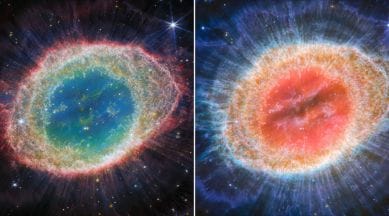Webb took another alluring image of Ring Nebula, revealing its intricacies
The Webb telescope is at it again. It took yet another image of the Ring Nebula and all its intricate details, helping scientists understand the lifecycle of stars like our Sun.

Within less than a month of a marvellous image of a Ring Nebula, the James Webb Space Telescope is back with yet another image of the planetary nebula that is officially known as Messier 57 or M57.
One of Webb’s first images was that of the Southern Ring Nebula. Just like that, this new image of the Ring Nebula shows the intricate structures that are part of the final stages of a dying stars. This image can tell us more about how stars like our Sun go through their lives and how they will end.
monthly limit of free stories.
with an Express account.
Messier 57, or M57, was born from a dying star that expelled its outer layers into space, making it a planetary nebula. Planetary nebulae come in a variety of shapes and patterns, some that include delicate glowing rings, wispy clouds and expanding bubbles
.“Planetary nebulae were once thought to be simple, round objects with a single dying star at the centre. They were named for their fuzzy, planet-like appearance through small telescopes. Only a few thousand years ago, that star was still a red giant that was shedding most of its mass. As a last farewell, the hot core now ionizes, or heats up, this expelled gas, and the nebula responds with colourful emission of light,” said Roger Wesson from Cardiff University in a press statement.
But thanks to modern technology like that found on Webb, we now know that these planetary nebulae have complex labyrinthine structures. But then the question is, how does a dying star, which is spherical, create such intricate and delicate non-spherical structures?
These shapes and patterns happen as a result of cosmic processes that are not yet well understood. Just like how fireworks can have different colours based on the compounds used in them, different chemical elements in the nebula emit light of specific colours. This means that astronomers can study the chemical evolution of these objects using pictures like this.